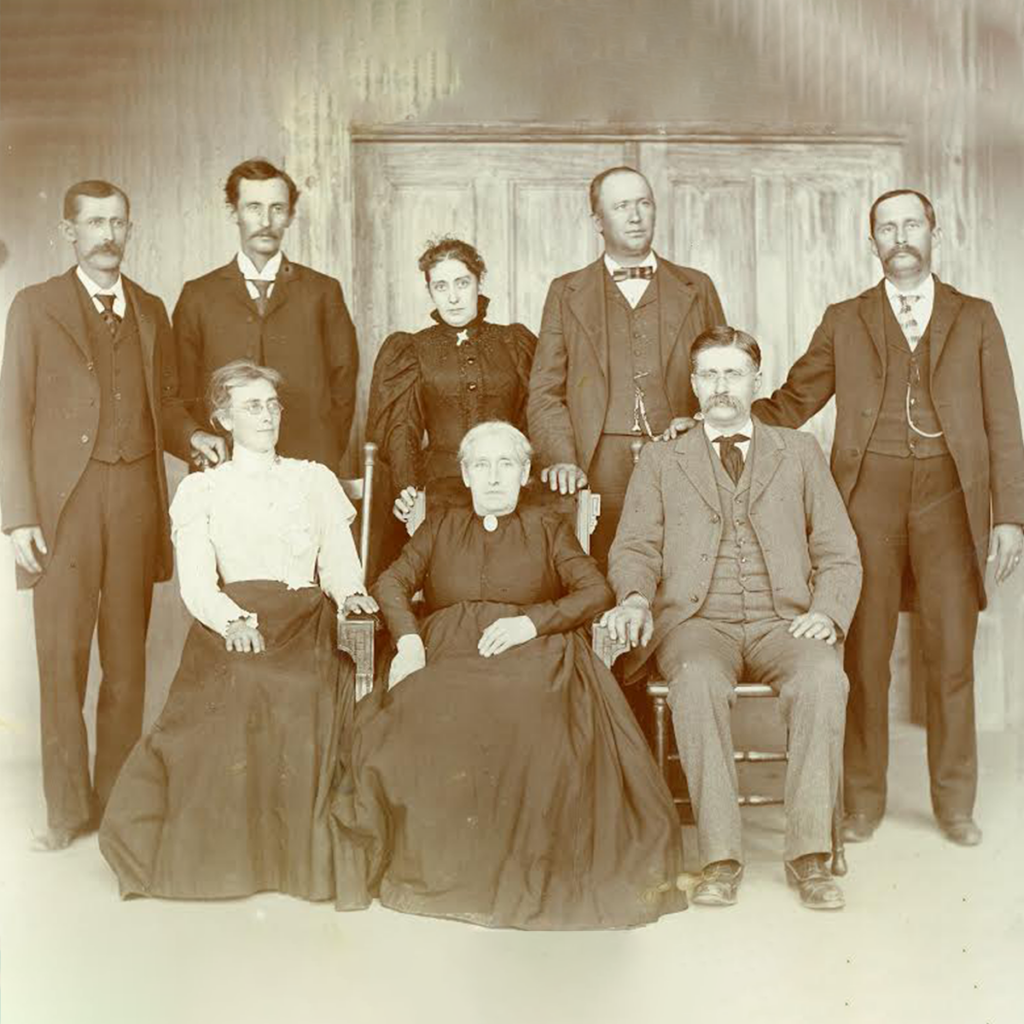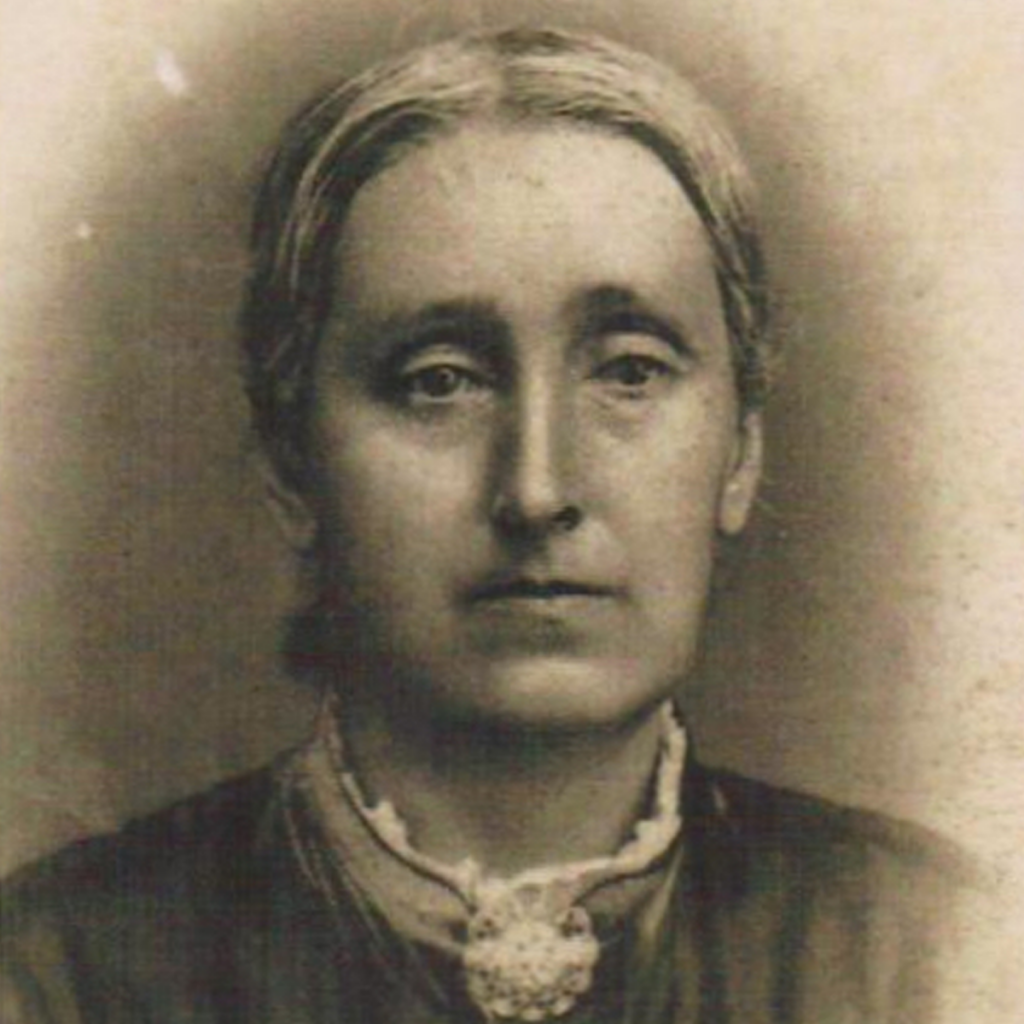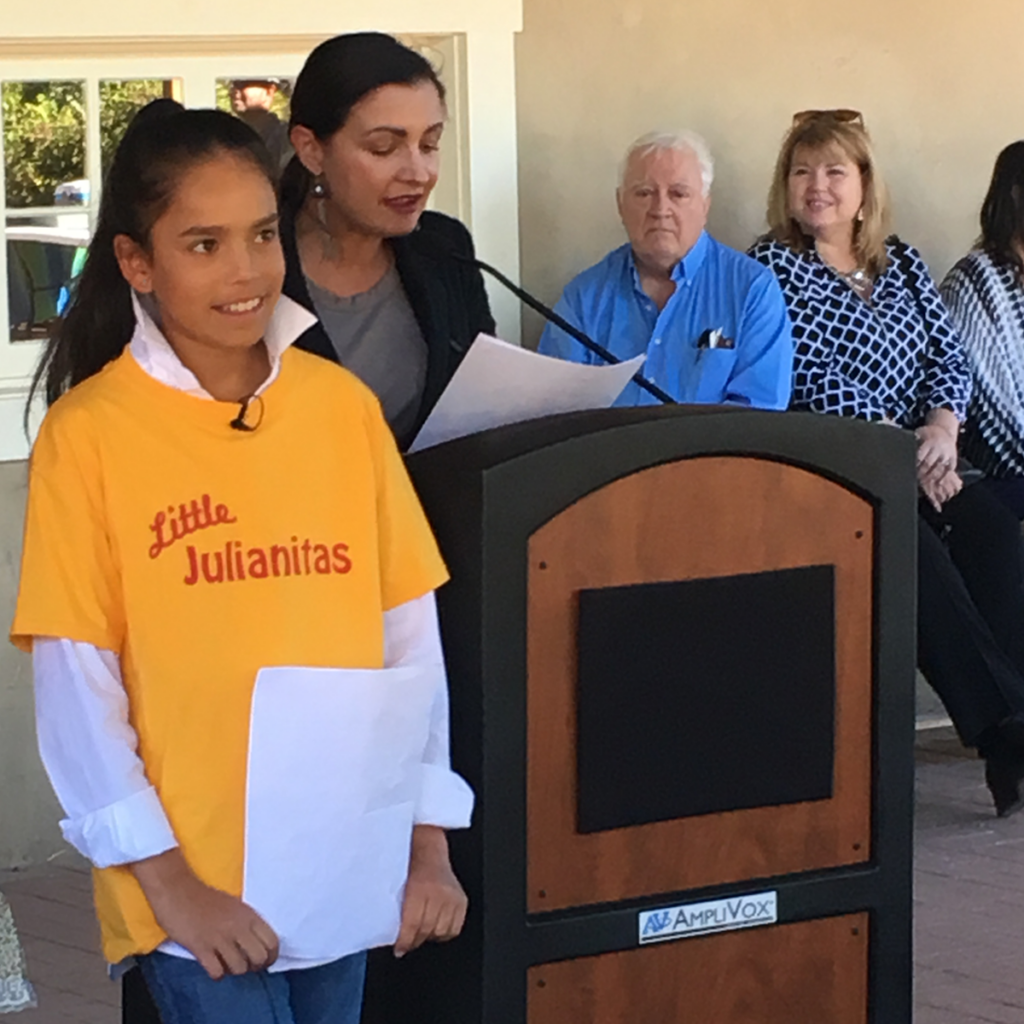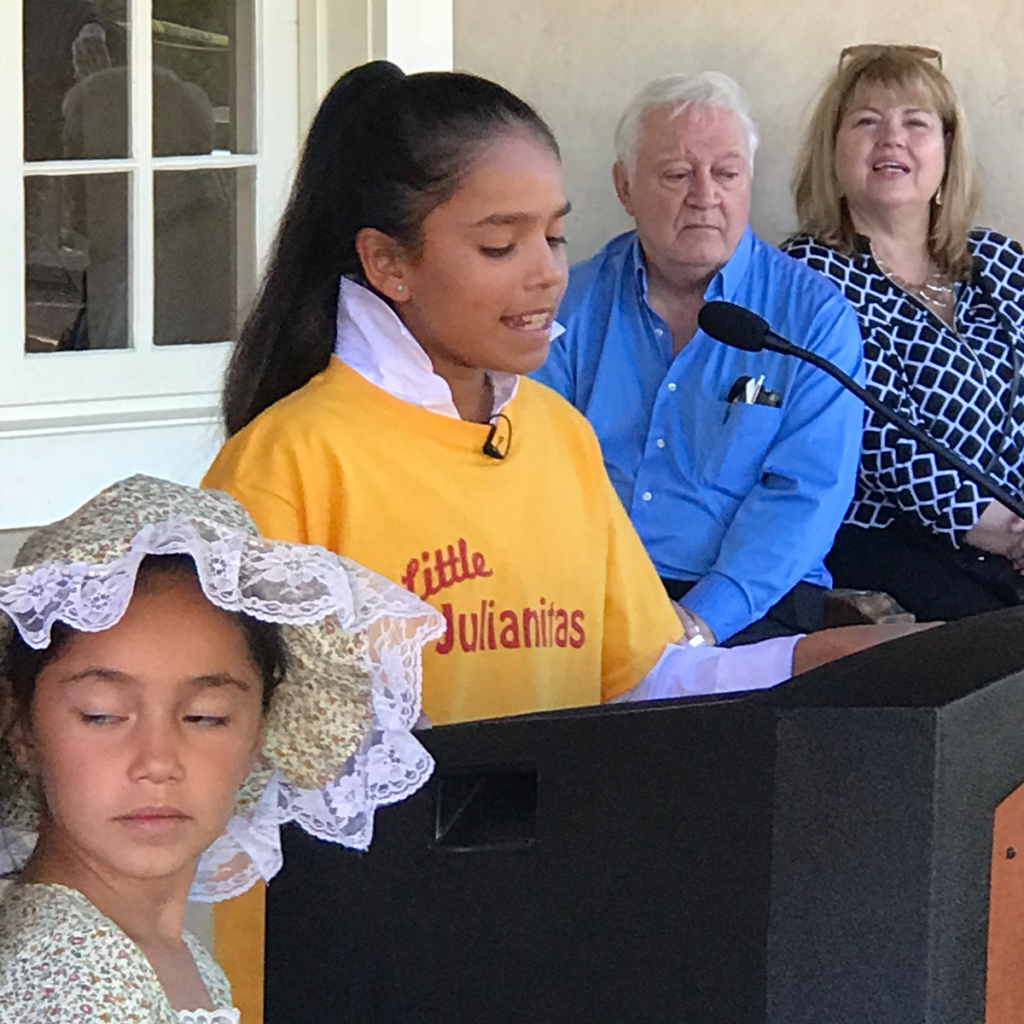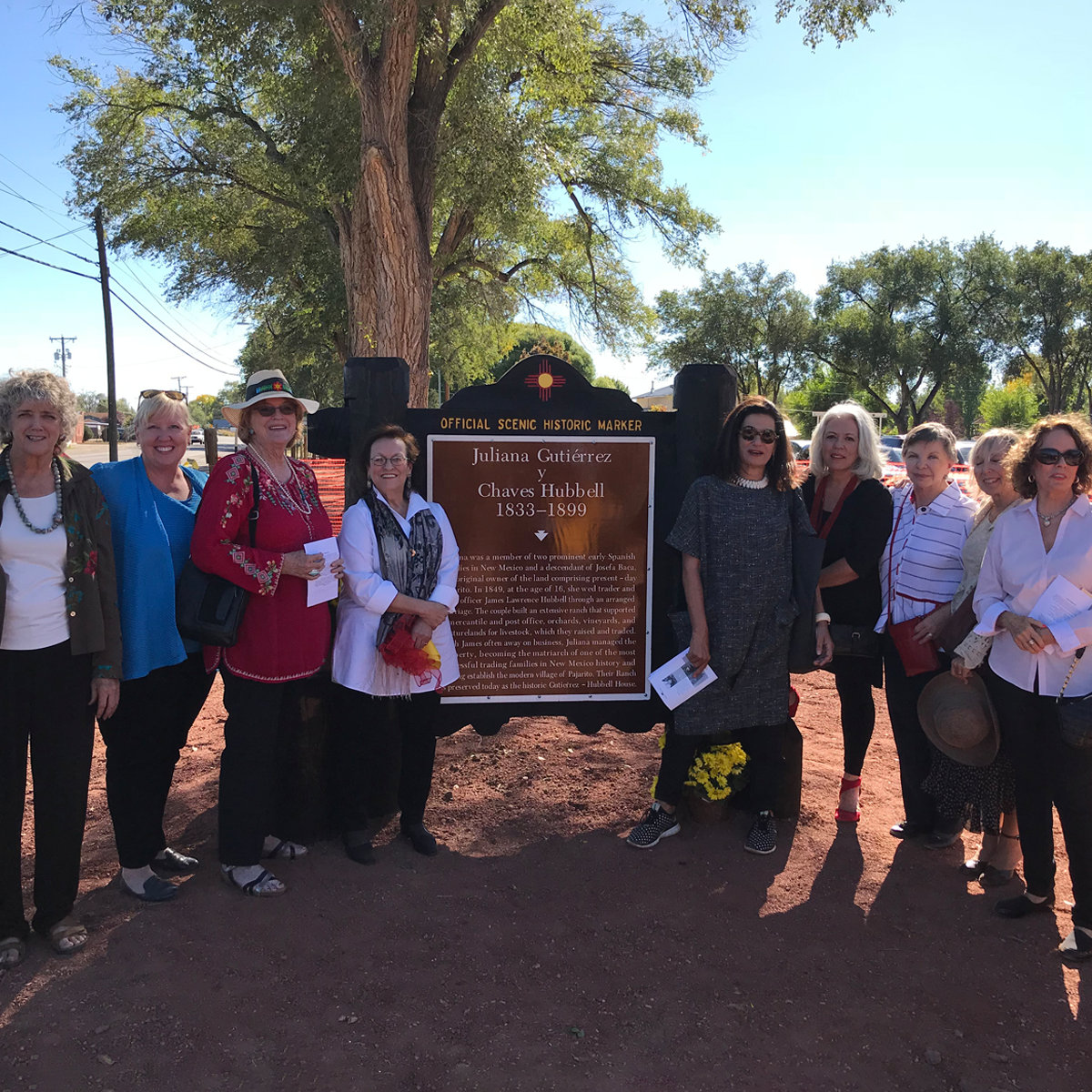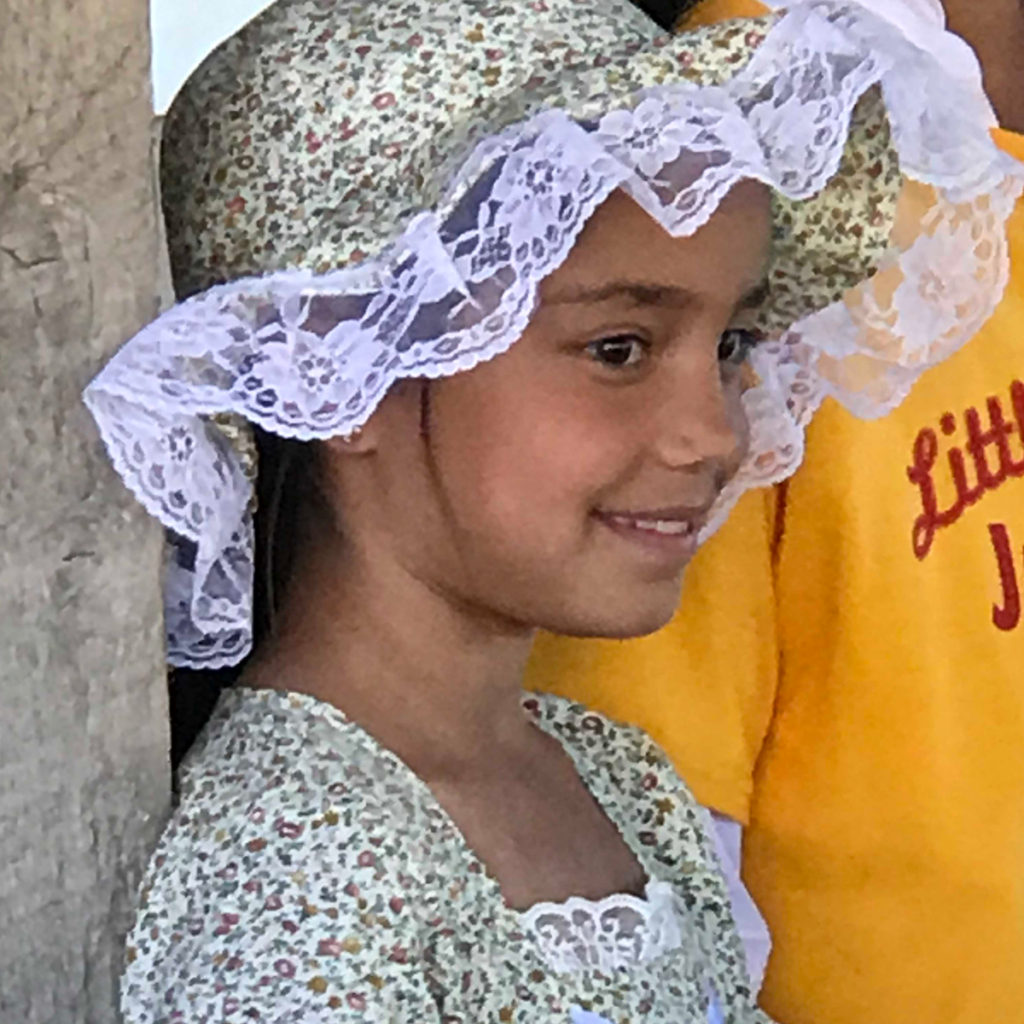Julianna Hubble (center) with some of her children.
Photo Credit: Public domain. Courtesy of New Mexico Historic Women Marker Program. Courtesy of New Mexico Historic Women Marker Program. Courtesy of New Mexico Historic Women Marker Program.
Juliana Gutiérrez y Chavez Hubbell
1833 - 1899
Bernalillo County
She and her husband built an extensive ranch that she often managed alone, becoming the matriarch of one of the most successful trading families in New Mexico history and helping establish the modern village of Pajarito. Their ranch is preserved today as the historic Gutiérrez-Hubbell House.
Juliana Gutiérrez y Chavez Hubbell was a member of two prominent early Spanish families in New Mexico and a descendant of Josefa Baca, a woman who was the original owner of the land comprising present-day Pajarito. In 1849, at the age of 16, she wed trader and army officer James Lawrence Hubbell through an arranged marriage. The couple built an extensive ranch that supported a mercantile and post office, orchards, vineyards, and pasturelands for livestock, which they raised and traded. With her husband often away on business, she managed the property, becoming the matriarch of one of the most successful trading families in New Mexico history and helping establish the modern village of Pajarito. Their ranch is preserved today as the historic Gutiérrez-Hubbell House.
Born in 1833, Juliana Gutiérrez was a descendant of Josefa Baca, the original owner of the “Sitio de Paraje,” a large tract of land that comprises today’s community of Pajarito. After Baca’s death around 1756, her son, Antonio, purchased much of the land she had left to her descendants. Antonio’s daughter married Clemente Gutiérrez in 1755, who acquired the Sitio de Parajito and other tracts, which he then passed on to his son, who passed them to Juan Nepomuceno Gutiérrez, the father of Juliana Gutiérrez.
Before they were succeeded by the Gutiérrez and Hubbell families, the Baca and Chavez families had become some of the wealthiest and most powerful families in New Mexico. They worked hard and creatively, developing large farming and ranching operations. By 1750, they were among the first traders, leading large caravans to Mexico and building a business empire that lasted into the 20th century. Family members were militia leaders and military officers, mayors, mayordomos, legislators, judges, and lawmen.
In 1849, Juan Nepomuceno Gutiérrez and his wife, Barbara Chavez Gutiérrez, an heir to the adjoining Atrisco land grant and daughter of Francisco Xavier Chavez, former governor of New Mexico under Mexican rule in 1822, arranged a marriage between their sixteen-year-old daughter Juliana (sometimes seen as Julianita) and James Lawrence “Santiago” Hubbell. The couple was married on March 31, 1849.
A display at the Gutiérrez-Hubbell House History and Cultural Center elaborates: “Alliances…were created through marriage. Marriage was seen by New Mexico’s ruling classes as a way to preserve racial purity, property, honor, and social position. They intermarried to maintain their social rank, wield political influence and control land.”
In 1848, Juliana’s father gave the couple a plot of land, on which they began to build the first part of what is now known as the Gutiérrez-Hubbell House. Constructed in four phases in the Territorial style, the first eight rooms of the house were built from 1855–1859 around a large central hall, an architectural innovation in New Mexico at the time. The design was influenced by Eastern styles admired by Hubbell. The three-room kitchen ell added in the mid-1860s formed a placita, one of the home’s key Hispanic architectural elements along with its 27-inch-thick adobe walls, flat roof, vigas, and milled planks. In 1867, two bedrooms were added and a year later the large mercantile wing was built north of them. The footprint of the 19-room, rambling structure is still evident. Thirteen of the rooms remain.
The house represented a mixture of architectural influences, as explained in a display at the Gutiérrez-Hubbell House History and Cultural Center: “The house was built in the early days after the U.S. took control of New Mexico and it reflects the dramatic clashing and mixing of cultures that marked this time. In the walls made of adobe and terrones (sod block), the viga (log) roof beams, and the orientation of the house to a back plaza, you see Spanish building techniques as shaped by Puebloan architecture. By contrast, the white painted Greek Revival wood trim around the windows and doors, the milled roof beams replacing vigas in some rooms, and the front porch reflect ideas and styles brought in from the American East.”
The house was also a physical manifestation of the powerful joining of the Gutiérrez and Hubbell families that helped accelerate development of the area. Sitting literally astride the Camino Real (present day Isleta Boulevard), the Gutiérrez-Hubbell House has served as something of a community center since its inception. Anecdotal stories state that residents of Pajarito sought safe shelter at the house during Indian attacks, and Juliana administered smallpox shots to residents. The mercantile and post office likely also served as gathering places. During the Civil War, Santiago Hubbell raised volunteer soldiers and served as a Captain in the Battle of Valverde near Socorro to help forestall the advance of Confederate troops through the state.
The extensive Gutiérrez-Hubbell property served as both a farm and a ranch, on which the family grazed more than 100,000 sheep. By 1871, the house had 19 rooms, a wagon shed, store, back room, two corrals, and 3,371 grape vines. James became one of the most successful stock raisers and traders in the region, driving livestock to surrounding states and Mexico, and supplying meat to fulfill U.S. Army contracts. With James often away, Juliana was responsible for the management of the ranch, children, and household. Juliana was active in local affairs and was considered the “matriarch” of the Pajarito community, someone to whom the local people came for help and advice.
The couple had twelve children, with eight surviving to adulthood. Their third child, Juan “Lorenzo” Hubbell (who later went by John), born in 1853, went on to establish an extensive trading operation with the Navajo Indians centered in the historic Hubbell Trading Post in Ganado, Arizona. Their eighth child, Frank A. Hubbell became a prominent merchant and operated “one of the largest and most historically significant sheep ranches in New Mexico history.” He later became a powerful politician.
In 1877, Juliana was among the petitioners claiming title to the land now comprising Pajarito before the Surveyor General. In their petition, Juliana and her siblings, Tomas and Ana Maria, among other petitioners, did not claim the land to be a land grant, stating only that they rightfully held title to it based on continued occupancy for 151 years. In a second claim made later, they did state that the land had originated from a land grant but stated the documentation for this had been lost or destroyed. In the second petition, Juliana Gutiérrez is not listed as a petitioner, but her sons, Frank and J. Felipe Hubbell, are. The grant, now known as the Pajarito Land Grant, was confirmed on September 8, 1894.
James Hubbell passed away in 1885. Juliana remained in the house until her own passing in 1899. The estate was divided among her surviving children and by 1930, much of the land was being sold for residential development. The closing of the Hubbell store and post office in 1929 marked the end of nearly 200 years of elite families dominating and shaping the life of the village of Pajarito. When the property went up for sale in 2000, Bernalillo County purchased the site along with 15 acres of the surrounding property, renovating the house over the next decade, and preserving it as a key part of the Hubbell House Open Space, the first open space area in Bernalillo County. The Gutiérrez-Hubbell House History and Cultural Center at 6029 Isleta Boulevard today preserves this grand estate, surrounded by orchards and open space, and is open to the public as a museum and a gathering place. It was listed on the State Register of Historic Properties in 1976 and the National Register of Historic Places in 2015.
Sources:
Interview: Flora Sanchez, docent, Gutiérrez-Hubbell House.
American National Biography. New York: Oxford University Press, 1999.
Briseño, Elaine D. “Talk Explores Pajarito Family History.” Albuquerque Journal,
Saturday, March 17, 2012.
Catanach-Hamm, Elizabeth. “The Hubbell House.” New Mexico Magazine, April
2004.
Gutiérrez-Hubbell House,
http://Gutiérrezhubbellhouse.org/history/ , accessed November 2, 2016.
Hubbell Trading Post: Official Map and Guide. National Park Service brochure.
Lane, Lawrence. “The Family History.” La Bandera de la Casa Hubbell-Gutiérrez,
September 2007.
Lujan, Elaine Patricia. “The Pajarito Land Grant: A Contextual Analysis of Its
Confirmation by the U.S. Government.” Natural Resources Journal, Vol. 48, Fall 2008.
Moyer, Curt. “The Frank A. Hubbell Company, Sheep and Cattle.” New Mexico
Historical Review, Vol. 54, Issue 1, 1979.
Moffson, Steven, “Hubbell, James Lawrence and Juliana Gutiérrez y Chaves House.” National Register of Historic Places Registration Form.
Davis, Mary and David Brugge. Gutiérrez-Hubbell House Historic Structures Report,
Cornerstones Community Partnerships, 2002.
Interview: Flora Sanchez, docent, Gutiérrez-Hubbell House
American National Biography. New York: Oxford University Press, 1999.
Briseño, Elaine D. “Talk Explores Pajarito Family History.” Albuquerque Journal,
Saturday, March 17, 2012.
Catanach-Hamm, Elizabeth. “The Hubbell House.” New Mexico Magazine, April
2004.
Gutiérrez-Hubbell House,
http://Gutiérrezhubbellhouse.org/history/ , accessed November 2, 2016.



